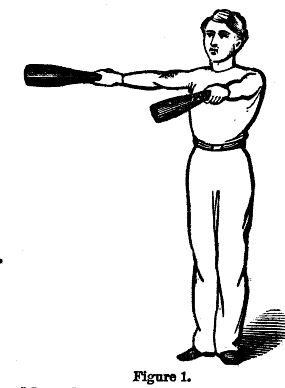
BY DIO LEWIS, M.D.,
PROPRIETOR OF THE ESSEX STREET GYMNASIUM, BOSTON.
WITH THREE HUNDRED ILLUSTRATIONS.
"By no other way can men approach nearer to the gods, than by conferring health on men." - CICERO.
THIRD EDITION
BOSTON:
TICKNOR AND FIELDS.
1862.
PREFACE.
This book describes and illustrates a new system of physical training. Like air and food, its exercises are adapted to both sexes, and to persons of all ages.
The new system has been introduced into female seminaries with complete satisfaction. Its beautiful games, graceful attitudes, and striking tableaux, possess a peculiar fascination for girls. Public classes, composed of adults of both sexes, elicit general enthusiasm. Children under three years of age are warmly interested, and improved in form and strength.
The exercises are arranged to music, and when performed by a class, are found to possess a charm superior to that of dancing and other social amusements, while the interest increases with the skill of the performers.
This system of exercises will correct drooping or distorted shoulders, malposition of the head, and many other common defects.
Its author has been engaged many years in teaching gymnastics. He began with a few simple exercises, and, making additions from time to time, has at length developed a very comprehensive system. Not one exercise is presented which has not been proved by long and varied use, while hundreds have been devised and rejected. Although the author has enjoyed during more than twenty years the discipline of the medical profession, its suggestions have not been adopted unless fully justified by experience in the gymnasium.
CLUB EXERCISES.
The more difficult club exercises are not practicable in class drills. For this reason I introduce only a few of the more simple, such as can be easily adapted to music and used in classes. Such slow tunes as the Marseilles, are the best for exercises with the clubs.
The clubs for men, if made of hard wood, should be about eighlteen inches long, and three or four inches in diameter. Women and children will adopt smaller ones. The floor should be so marked that the performers may, with certainty, occupy positions securing them against injuries from each other's clubs. If this be neglected a contusion of the knuckles, elbow, or head may greatly mar the pleasure of the lesson.
No. 1. The clubs hang at the sides, each hand grasping firmly, being careful not to push the index finger toward the body of the club, but keep it close with the rest of the hand. First raise the right arm as the left is represented in Fig. 1, five times. Same with the left. Then alternately and simultaneously, each five times.

Let it not be forgotten that in every exercise where it is possible, the right arm performs the feat first, then the left, then the two arms alternately, and last of all simultaneously. In each case the feat is to be executed five times. If the teacher would make these exercises interesting and useful, he must insist upon the greatest accuracy. When the word of command is "horizontal," the club must be held exactly horizontal. When the word is "perpendicular," it should not vary from the perpendicular half an inch. In nearly all club exercises the arms must not be bent at the elbow. This point is very important, and very difficult to enforce.
No. 2. Raise the right arm and club as represented in Fig. 1. Left the same, etc.
No. 3. Holding the right as the left is represented in Fig. 2, carry it directly upward until it is perpendicular. Left the same, etc.
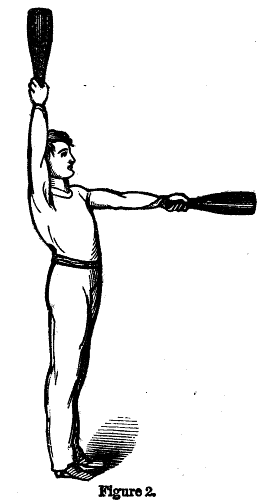
No. 4. Holding the right as it is represented in Fig. 1, carry it directly upward sidewise until it is perpendicular. Left the same. etc.
No. 5. Right club should hang by the right leg. Carry it upward directly in front, until it is perpendicular over the shoulder. Left the same, etc.
No. 6. Right club hang by the side of the right leg. Carry it directly upward sidewise until perpendicular over the shoulder. Left the same, etc.
No. 7. Perform the right arm exercise of No. 2, and the left of No. 1, alternately and simultaneously.
No. 8. Execute the right of No. 3, and the left of No. 2, alternately and simultaneously.
No. 9. The right of No. 4, and the left of No. 3, alternately and simultaneously.
No. 10. The right of No. 5, and the left of No. 4, alternately and simultaneously.
No. 11. The right of No. 6, and the left of No. 5, alternately and simultaneously.
No. 12. Hold the two clubs as the left is represented in Fig. 2, without moving the arms, but simply by bending the wrist, and with a slow motion lay the right club down on its own arm. As it is carried back bring the left one down, and then work the two simultaneously.
No. 13. H old the arms horizontal at the sides, as the right arm is shown in Fig 1, and execute the same exercise as in No. 12.
No. 14. Holding the two arms horizontal in front, and the clubs perpendicular, let the clubs fall sidewise, both to the right, until they are horizontal; then to the left, and so alternate five times. Now let them fall toward each other, then from each other, and so alternate five times.
No. 15. Hold the arms horizontal at the sides, and execute the same exercise as in No. 14.
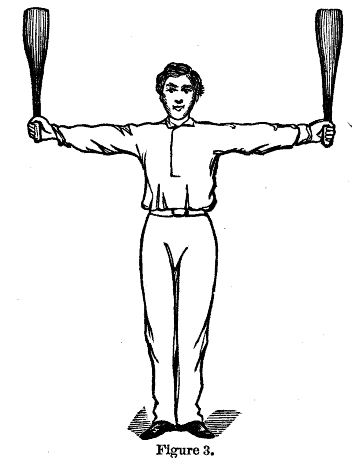
No. 16. Arms horizontal in front, clubs perpendicular. Now carry the two arms in the horizontal plane, Figure 3. without bending the elbows, backward as far as possible. (Fig. 3.) Halting touch the farther ends of the clubs on the back of the neck. Carry them out again to the position seen in Fig. 3. Now let the farther ends of the clubs touch at the nose. Carry them back again to Fig. 3 position. Let them fall backward, so that they hang down vertically, (Fig. 4.) but without moving the arms other than with a twisting motion. In this the hands must not be allowed to give way on the handle, but must grasp firmly. To reach this vertical position of the clubs as they fall behind, it is necessary to bend the back considerably. Raise the clubs again to Fig. 3 position, and allow them to fall again, but this time forward, and until they reach the vertical position. Thus alternate between the fall backward and forward, five times, and end by bringing the clubs to the hanging position by the side of the legs.
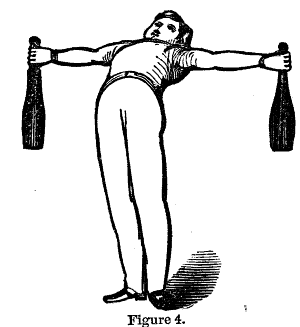
No. 17. Hold the clubs as represented in Fig. 5. Carry their farther ends directly upward as far as you can reach them, and let them fall behind upon the shoulder blades. Thus alternate five times, or, if you please, fifty times.
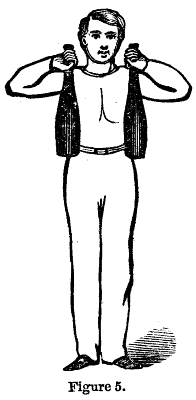
No. 18. Hold the clubs as represented in Fig. 5, except they should be the other end up. Push the right one directly off the shoulder backward, and bringing it down by the side, raise it until it is horizontal in front. Now while this one is returning in the same track to the place of beginning, let the left one perform the same journey. And so alternate five times.
No. 19. Beginning as in No. 18, thrust the arms upwards and sidewise as seen in Fig. 6, and bringing them close down by the legs in front, carry them completely around the back, letting them fall down as far as possible and bring them to the chest, in the beginning position; thrust them up and out on the other side of the body, and carry them around the body the other way. Alternate five times.
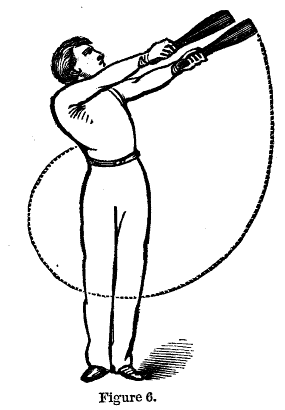
No. 20. Holding the clubs as represented in Fig. 7, one exactly in front, the other behind, and both horizontal; carry them directly upward, and as they pass each other over the head they should be not more than one foot apart. Upon reaching the horizontal, the clubs, as will be seen, are exactly reversed. Be careful in this exercise not to bend the elbows or wrists. Continue five times.
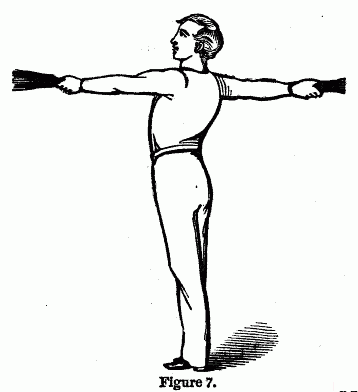
No. 21. Holding the body, arms and clubs, as seen in Fig. 8, reverse the arms five times. If elbows or wrists be bent the exercise is lost.
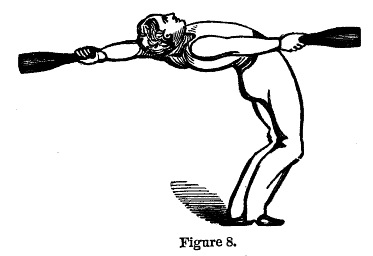
No. 22. Holding the right club as represented in Fig. 2, and letting the left hang by the side, whirl the right slowly, in the horizontal plane, keeping the elbow and wrist quite stiff, (as in nearly all the other exercises,) and make a perfect circle with the farther end of the club. Then the same with the left. Alternately and simultaneously. The whirling in all the above is forward.
Now go over the same, whirling the club backward. Then whirl, with the same changes in front of the body, and lastly behind the back.